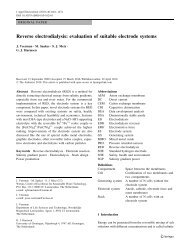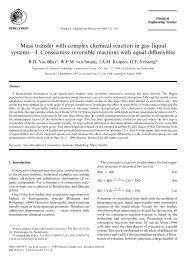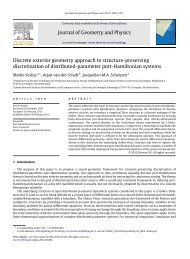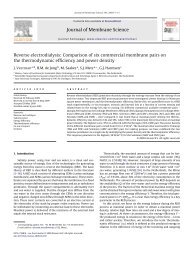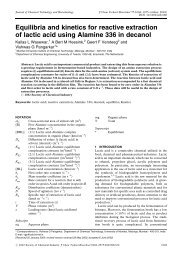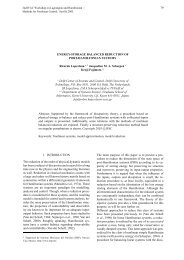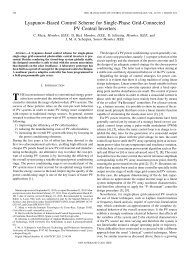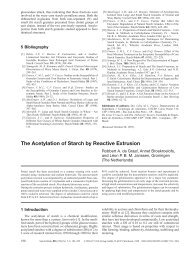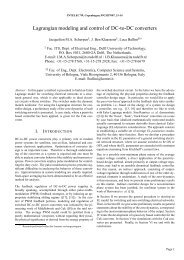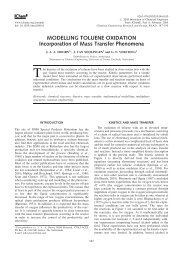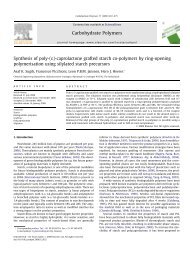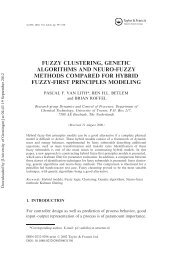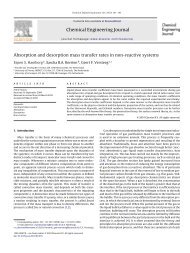Blends of styrene-butadiene-styrene triblock copolymer with ... - ITM
Blends of styrene-butadiene-styrene triblock copolymer with ... - ITM
Blends of styrene-butadiene-styrene triblock copolymer with ... - ITM
You also want an ePaper? Increase the reach of your titles
YUMPU automatically turns print PDFs into web optimized ePapers that Google loves.
<strong>Blends</strong> <strong>of</strong> Styrene-Butadiene-Styrene Triblock Copolymer ... 1399Table 2.TGA analysis <strong>of</strong> SBS/PS-co-MA blends.Sample a) T db)SBS 430PS-co-MA 7% 389PS-co-MA 14% 375SBS/PS-co-MA 7% 90/10 432SBS/PS-co-MA 7% 80/20 402SBS/PS-co-MA 14% 90/10 435SBS/PS-co-MA 14% 80/20 419a) <strong>Blends</strong> composition is expressed in weight ratios.b) Evaluated as upturn point <strong>of</strong> TGA 1 st -derivative curve.8CFigure 3.Tan(d) curves for SBS/PS-co-MA 7% blends.perature curves, <strong>with</strong> respect to that <strong>of</strong> neat SBS. The sameobservation can be extrapolated from the maximums <strong>of</strong>tan(d) curves (Figure 3 and 4), which shift in generaltowards high temperature <strong>with</strong> respect to the virgin SBS.Moreover, blends <strong>with</strong> 5–10 wt.-% <strong>of</strong> PS-co-MA arecharacterized by the highest tan(d) peak temperatures <strong>with</strong>respect to the other compositions. It must also be stressedthat the evident broadening <strong>of</strong> tan(d) peak correspondingto a 10 wt.-% PS-co-MA substantially agrees <strong>with</strong> whatalready has been reported in the literature [21] about similarsystems and strongly addresses the synergism <strong>of</strong> propertiesfor this particular composition. The relative decrease <strong>of</strong> thestorage modulus in correspondence to the glass transitiontemperature <strong>of</strong> the blends hard phase displays its minimumvalues for the 90/10 compositions clearly indicating thatthese blends are much stiffer than the pure <strong>copolymer</strong> andthe other mixtures. The fact that synergism takes place moreevidently in correspondence <strong>of</strong> the 90/10 composition maysuggest that in this case probably a saturation <strong>of</strong> the PSTable 3.DMTA analysis <strong>of</strong> SBS/PS-co-MA blends.Sample a) T g tan(d) DE/E b) DT b)domains interface by the PS-co-MA component has alreadybeen achieved. Accordingly, for higher PS-co-MA contents,a new PS-rich phase could be formed by the excessPS-co-MA leading to phase separation and worsening <strong>of</strong> themechanical properties. This hypothesis is in agreement towhat already has been suggested in the literature [22] aboutSBS/PS blends, the only difference being in the fact that thesolubility-limiting factor is not, in our case, the molecularweight <strong>of</strong> the added component but its amount <strong>with</strong> respectto the SBS <strong>triblock</strong> <strong>copolymer</strong>.Some preliminary attempts to neutralize the MA groupsin dynamic conditions, i.e. during processing, were performedby adding a stoichiometric amount <strong>of</strong> Zn(OAc) 2directly into the mixer together <strong>with</strong> the two polymers.FT-IR spectra <strong>of</strong> the ‘‘neutralized blends’’ (Figure 5and 6) show the presence <strong>of</strong> bands characteristic <strong>of</strong> thezinc-neutralized anhydride groups (at around 1 560 and1 630 cm 1 ) [23,24] but also those <strong>of</strong> the unreacted MAgroups, i.e. the neutralization reaction was not completeunder the experimental conditions used. DSC analysiscarried out on these blends (Table 1) shows a quiteanomalous behavior. In fact, when using 10 wt.-% <strong>of</strong> PSco-MAonly one T g was clearly detectable by DSC after8C 8C % 8CSBS 64.6 78.2 82.8 50–78SBS/PS-co-MA 7% 95/5 86.8 98.9 87.9 50–100SBS/PS-co-MA 7% 90/10 80.0 94.6 31.2 50–80SBS/PS-co-MA 7% 85/15 78.2 93.8 n.d –SBS/PS-co-MA 7% 80/20 76.0 83.6 60.2 50–80SBS/PS-co-MA 14% 95/5 87.7 98.5 53.2 50–80SBS/PS-co-MA 14% 90/10 88.0 100.2 28.5 50–100SBS/PS-co-MA 14% 85/15 76.2 97.5 28.4 50–80SBS/PS-co-MA 14% 80/20 72.3 83.5 73.5 50–80a) <strong>Blends</strong> composition is expressed in weight ratios.b) Relative decrease <strong>of</strong> the storage modulus (DE/E) calculatedas E1 ðT 1Þ E 1 ðT 2ÞE 1 ðT 1Þ 100 where the T 1 T 2 ¼ DT range has beenchosen in order to comprise the hard phases glass transitiontemperature.Figure 4.Tan(d) curves for SBS/PS-co-MA 14% blends.



